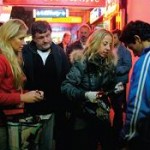Underbelly: the golden franchise
 Its creators never thought Underbelly would go that far, but now they’re walking their third mile in 80s style. For the new instalment The Golden Mile, ultra-contemporary thinking meets retro styling. Laine Lister got the low down on big hair, bent cops and vintage number plates.
Its creators never thought Underbelly would go that far, but now they’re walking their third mile in 80s style. For the new instalment The Golden Mile, ultra-contemporary thinking meets retro styling. Laine Lister got the low down on big hair, bent cops and vintage number plates.
Sometimes, it’s the most insignificant details that are the most telling. A glimpse of modern architecture or a brand of jeans can reveal a lot, and potentially damage the reputation of a drama set in the past.
And then there’s the matter of numberplates, which are easy to get wrong and a favourite thing for people watching the series to check on, says production designer Paddy Reardon.
“We deal with the motor registration boards to make sure but even now, I know that there will be people going through the series and scrutinising any visible number plates to determine whether they are the right period or not,” he says.

